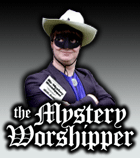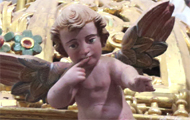| |
 |
 |
 |
| Comment on this report, or find other reports. |
 |
| Our Mystery Worshippers are volunteers who warm church pews for us around the world. If you'd like to become a Mystery Worshipper, start here. |
 |
| Find out how to reproduce this report in your church magazine or website. |
|
|
| 1747: Pohick
Church, Lorton, Virginia, USA |
 |
 |
 |
Mystery Worshipper:
Amanda B. Reckondwythe.
The church:
Pohick Church,
Lorton, Virginia, USA.
Denomination:
The Episcopal Church, Diocese
of Virginia.
The building:
A rectangular brick colonial church sitting in a park-like churchyard.
The building dates from 1767 and was erected on a site chosen
by future president George Washington, with Washington himself
supervising the construction. The church was abandoned in the
early 19th century and fell into disrepair. But renewed interest
in "General Washington’s church" spurred a restoration
effort interrupted by the Civil War, when soldiers used the
building as a stable and field hospital, covering the interior
with graffiti and pock-marking the exterior with bullet holes,
some of which are visible to this day. Civil War photographer
Mathew B. Brady documented the damage. By the end of the war
the building was windowless, doorless, nearly roofless, blackened
by smoke and stripped of all its appointments. It was not until
1890 that another major restoration was undertaken. The fruits
of that effort have resulted in an open and airy interior, painted
white throughout, with box pews, an organ loft, and a tiny chancel.
Behind the altar are murals of the Apostles’ Creed, the Lord’s
Prayer and the Ten Commandments. A raised canopied pulpit is
off to the left, and the baptismal font stands in the center
of the congregation. The font is the only surviving artifact
from the original church.
The church:
The parish was founded in 1689 and took its name from that of
a nearby creek. Not only George Washington, but his father Augustine,
served as vestrymen. The Revd Mason Locke Weems was a sometime
preacher at Pohick between 1800 and 1817. Parson Weems is remembered
as the author of several tales, probably apocryphal, about George
Washington, including the
anecdote of the cherry tree, which every American schoolchild
can recite. Today the congregation sponsors all the usual activities,
as noted on its website, and is well aware of the historic significance
of the building and the parish.
The neighbourhood:
Lorton is a "census-designated place" situated in
northern Virginia just south of Alexandria. Until 2001 it was
home to the Lorton Reformatory, an infamous prison where, in
the early 20th century, women arrested for taking part in the
suffragette movement were housed. Today Lorton is known primarily
as the northern terminus of Amtrak’s Auto-Train to Florida.
Good rail service into Washington, DC makes Lorton an ideal
suburban bedroom community. Lorton is trying hard to become
a yuppie enclave, with new restaurants springing up in the vicinity
of the railroad station and the old prison being converted into
artists’ studios and a performing arts center. Nearby are Fort
Belvoir, a major U.S. Army installation; and Mount Vernon, George
Washington’s home. The church is located along Route 1 at the
southern edge of Fort Belvoir.
The cast: The Rt Revd David Colin Jones, Suffragan Bishop of Virginia, was the celebrant. He was assisted by the Revd Donald D. Binder, rector, and the Revd Lyn Youll Marshall, assistant rector.
The date & time: Sunday, June 14, 2009, 10.00am.
What was the name of the service?
Bishop’s Visitation with Baptisms, Confirmations, Receptions and Reaffirmation.
How full was the building?
I counted room for about 230, more or less, in the box pews. The church was completely full. Folding chairs had been set out in the aisles, and several people were standing in the back.
Did anyone welcome you personally?
An usher said hello as he handed me the bulletin. Another usher asked if I was a visitor. As people were seated in my box pew, we exchanged pleasantries.
Was your pew comfortable?
The box pews were the most uncomfortable church seating I have
ever experienced. There was barely room to sit, let alone stand
or hold the prayer book or hymnal. I had to escape out into
the aisle after the sermon. The fact that fully half the seats
faced away from the altar must have helped George Washington
and friends catch up on their sleep while Parson Weems droned
on. Interestingly, although Washington was a faithful churchgoer,
it is said that he rarely if ever took communion. Perhaps he
slept through it?
How would you describe the pre-service
atmosphere?
The baptismal and confirmation parties settled into their reserved boxes and visited amongst themselves as if in their front parlors. As the non-reserved boxes filled up, people likewise visited. The church bell was rung 15 minutes before the service, and the organist began a prelude, which just made people talk louder.
What were the exact opening words of the
service?
"Good morning. Today we will have the service of baptism along with the service of confirmation and reception." This by the bishop, who was vested merely in rochet, chimere and tippet. No mitre, no crosier, no cope, and certainly no chasuble.
What books did the congregation use during the
service?
Prayer Book 1979, Hymnal 1982, and service
leaflet. Also in the pews were Lift Every Voice and Sing
and The Holy Bible, Revised Standard Version, but they
were not used.
What musical instruments were played?
Organ, played by Linda Egan, and two trumpets, played by Susan Rider and James McClarty. The organ was built in 1968 to 18th century specifications by the Noack Organ Company of Georgetown, Massachusetts, and restored in 2005 by David M. Story Inc. of Baltimore, Maryland. There was also a choir of about 14 voices who were robed in cottas and blue cassocks and who sang from the gallery.

Did anything distract you?
Out in the churchyard I noticed an intricate weaving of spider
webs in the iron fencing around some old tombstones. Spooky!
The effort it took to gain some measure of comfort in the box
pews was most distracting – and ultimately futile. The fact
that the pews were originally owned by families made me wonder
what Mystery Worshipping would have been like in colonial times,
when the accusation "You’re sitting in our pew!"
actually carried some meaning. There was also the usual chorus
of crying babies, who were especially distracting during the
bishop’s sermon.
Was the worship stiff-upper-lip, happy clappy, or
what?
Decidedly low church – lower than Death Valley during a new
moon! To complement the bishop’s minimalist vestiture, the two
priests wore only alb and stole. There were six baptismal candidates,
twenty-one confirmands, two adults to be received, and one to
be reaffirmed. The assistant rector performed the baptisms,
and the bishop followed up with the chrismation. The bishop
conducted the confirmations, receptions and reaffirmation from
a chair that appeared to have been taken from someone’s dining
room. Nothing was chanted except for the psalm, which was done
to Anglican chant. There were no bells or incense, although
two candles were lit on the altar ("Papist!" George
Washington would have hissed). Other than the psalm, the only
part of the service that was sung was the Sanctus, which was
the familiar Schubert setting done very nicely at the proper
tempo. The choir’s offertory anthem was Beethoven’s The
Heavens Are Telling. As much as I love Beethoven, I don’t
regard choral music as one of his fortes, but the choir did
an admirable job. We stood during the eucharistic prayer – how
could we have knelt in those box pews, even though cushions
were provided?
Exactly how long was the sermon?
14 minutes.
On a scale of 1-10, how good was the preacher?
8 – The bishop mounted the pulpit. He had notes in front of him but barely glanced at them. He spoke clearly and his remarks were well prepared.
In a nutshell, what was the sermon
about?
He began with an anecdote about how upset his five-year-old son was when his sister mischievously uprooted a vineyard in their back yard. The boy surprised his father by remarking that the sister didn’t realize how much love had gone into tending the vineyard. That incident gives us a glimpse of God’s love. It is easy to be thoughtless and careless, especially with how we raise children. The seeds planted in baptism and confirmation will grow, but only if they are nurtured. By presenting candidates for baptism and confirmation, parents and godparents dedicate their children to God forever – a responsibility not to be taken lightly. Everything in the life of the church is founded on the promise of baptism. Our belonging to God defines who we are – Christians. With the proper nurturing, we will flourish, and our growth cannot be stopped.
Which part of the service was like being in
heaven?
The confirmation ceremony was especially moving, as the confirmands knelt in turn before the bishop as he pronounced the words of the sacrament.
And which part was like being in... er... the other place?
As happens too often, the exchange of peace turned into a social intermission – although if truth be told, after six baptisms, twenty-one confirmations, two receptions and one affirmation, an intermission was welcome! But unfortunately communion, too, turned into a social. As a practical matter, only the occupants of one box at a time could go up for communion, and while the others were waiting their turn, they all socialized almost as vigorously as they had done before the service. And this despite the fact that the organ was playing away and the choir were singing the announced communion hymns. God forbid anyone should pick up a hymnal – I almost suggested to one box that they just might do so! I asked one of the ushers if communion were always this festive, and he replied yes as though he were surprised I had asked.
What happened when you hung around after the service looking lost?
I interrupted one woman’s socializing long enough to grab a
hymnal from her pew in order to join in the final hymn. When
that was over, everyone cleared out pretty fast, as photo ops
had been scheduled for out on the lawn. As I shook the bishop’s
hand, I told him that I’ve seen high church, low church, and
everything in between, but that this was the lowest service
I had ever seen. He merely smiled. An usher told me, "This
is Virginia, not Washington. We’ve always been low church here."
How would you describe the after-service
coffee?
A reception had been planned in the parish hall. There were two kinds of punch, coffee, and hot water for tea, as well as vegetables and dip, deviled eggs, cheese and crackers, tarts, cookies and cake. I didn’t sample the coffee but the punch was very good, as were the veggies and cake.
How would you feel about making this church your regular (where 10 = ecstatic, 0 = terminal)?
1 – No way. I couldn’t take those box pews. And I need some ceremony. It did seem like a very friendly and caring congregation, though. I have no complaints about the welcome I received.
Did the service make you feel glad to be a
Christian?
Yes. It’s always wonderful to see people being received into the church, whether low or high.
What one thing will you remember about all this in seven days' time?
The amount of socializing that went on during communion. |
|
|
 |
 |
 |
| We rely on voluntary donations to stay online. If you're a regular visitor to Ship of Fools, please consider supporting us. |
 |
 |
 |
| The Mystery Pilgrim |
 |
| One of our most seasoned reporters makes the Camino pilgrimage to Santiago de Compostela in Spain. Read here. |
 |
 |
 |
| London churches |
 |
| Read reports from 70 London churches, visited by a small army of Mystery Worshippers on one single Sunday. Read here. |
| |
|
|
|
|


